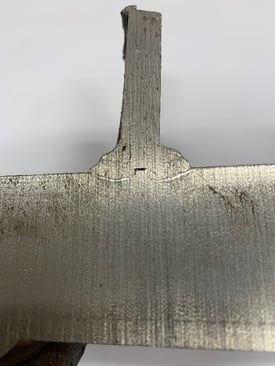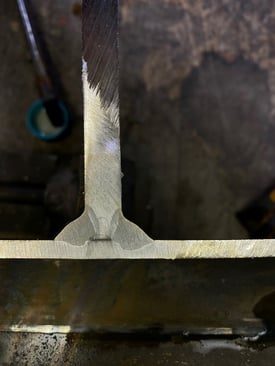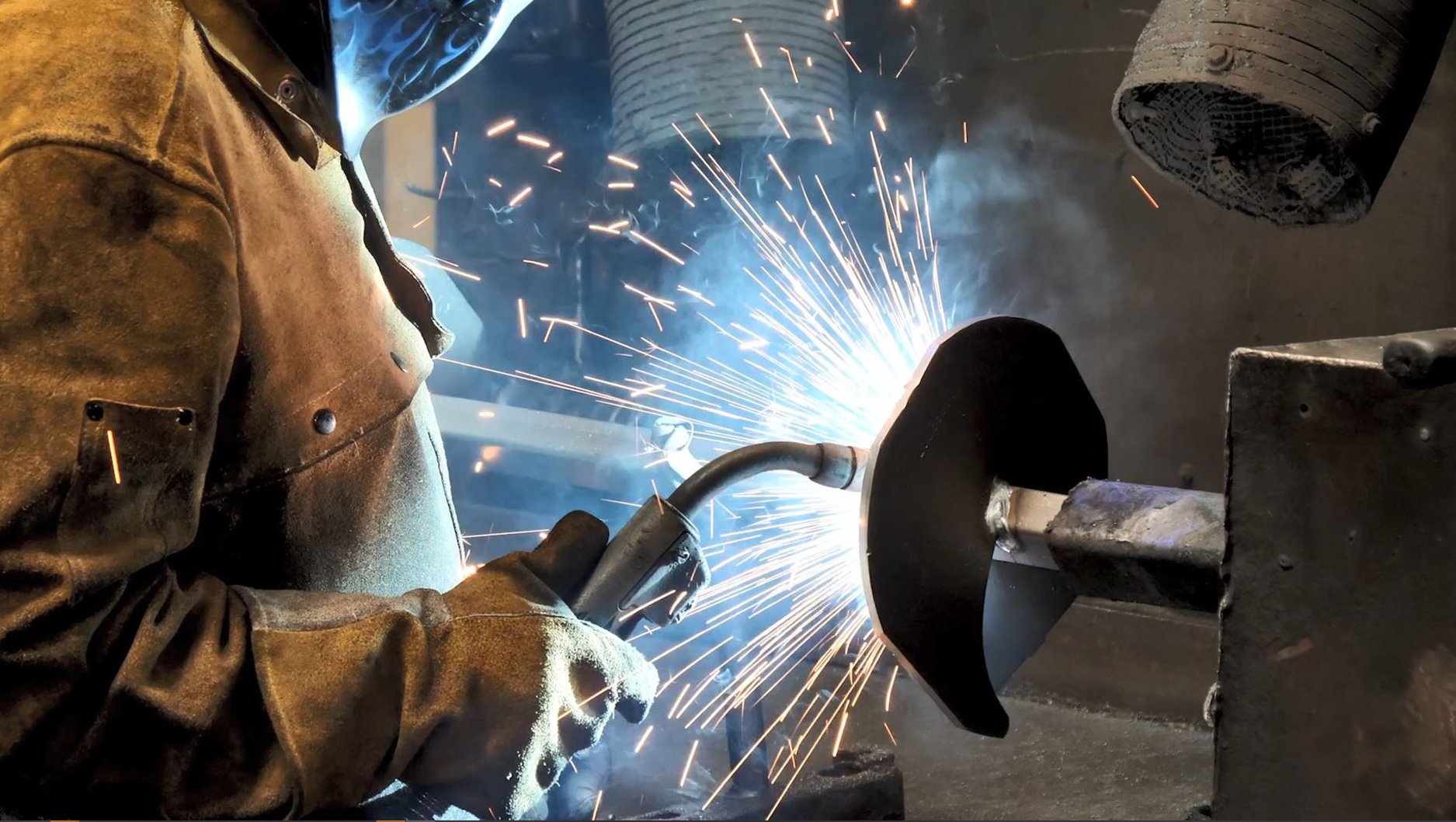There are many different weld processes that can be used in the production of helical piles to join a helix to a shaft. Each of these weld processes has many variables such as:
- filler metal strength
- filler metal feed rate
- shielding gas composition
- shielding gas flow rate
- amperage
- targeting
- torch angle
- preheat
- integration of automation
It is imperative for a helical pile manufacturer to have quality controls that test, maintain, and control these variables to ensure repeatable and reliable structural welds.
CHANCE® helical piles are welded per the requirements of the American Welding Society’s structural welding code, AWS D1.1/D1.1M. This code outlines the requirements for quality control and defines a structural weld. It is commonly known that the code outlines recommendations, prequalified materials, and profile requirements of weld joints. However, the recommendations are only a small fraction of the content within the code. No structural welding code book could cover all steel types and weld joints. Therefore, a large portion of the code is dedicated to the quality controls that are required to qualify a weld joint that is outside the recommendations or pre-qualifications. To transfer the high torque and structural loads expected for today’s helical piles, they are generally designed with proprietary or less-common, high-strength steels that have yield strengths ranging from 50 to 100 ksi. This means that most steels used for helical piles are not prequalified materials, and the performance requirements for each joint must be tested.
Testing Welds and Ensuring Quality
 All weld joints on CHANCE helical piles will have a Procedure Qualification Record (PQR) and a Welding Procedure Specification (WPS). The requirements of these two documents and the testing required to develop these documents are outlined by and conform to AWS D1.1/D1.1M. A PQR on prequalified materials and variables may be obtained directly from the structural welding code, as applicable. If the materials or variables are not prequalified, samples must be made and tested for each type of joint. The samples are welded in the same position in which the helical piles will be welded. For example, requirements for a fillet joint on a CHANCE square shaft helical pile specify testing of a T-shaped sample made from the thickest material used in the joint welded to the thinnest material used in the joint (i.e., a piece of shaft and a piece of the thinnest plate used to make the helix). This creates a fillet weld joint on each side of the T. One side is welded with the smallest multi-pass weld used in the joint and the other is welded with the largest single-pass weld used in the joint. All variables are recorded for each weld sample.
All weld joints on CHANCE helical piles will have a Procedure Qualification Record (PQR) and a Welding Procedure Specification (WPS). The requirements of these two documents and the testing required to develop these documents are outlined by and conform to AWS D1.1/D1.1M. A PQR on prequalified materials and variables may be obtained directly from the structural welding code, as applicable. If the materials or variables are not prequalified, samples must be made and tested for each type of joint. The samples are welded in the same position in which the helical piles will be welded. For example, requirements for a fillet joint on a CHANCE square shaft helical pile specify testing of a T-shaped sample made from the thickest material used in the joint welded to the thinnest material used in the joint (i.e., a piece of shaft and a piece of the thinnest plate used to make the helix). This creates a fillet weld joint on each side of the T. One side is welded with the smallest multi-pass weld used in the joint and the other is welded with the largest single-pass weld used in the joint. All variables are recorded for each weld sample.
 The weld sample is then cross-sectioned in 3 places, and the exposed weld surfaces are polished and etched with acid so the welds can be visually examined for root penetration and fusion depth. All welds must be completely fused to the base metal to create a homogeneous structure.
The weld sample is then cross-sectioned in 3 places, and the exposed weld surfaces are polished and etched with acid so the welds can be visually examined for root penetration and fusion depth. All welds must be completely fused to the base metal to create a homogeneous structure.
Welding specifications by Hubbell, the manufacturer of CHANCE helical piles, require adequate root penetration and depth of fusion to ensure that the weld pulls out base metal or breaks through the weld throat when the plate of the T-shaped sample is bent to failure. This ensures the weld is developing the maximum protentional shear strength of the weld. If visual inspection and testing results are acceptable, an AWS Certified Weld Inspector (CWI) will complete and sign off on the PQR and WPS. The WPS specifies the parameters required to consistently generate high-quality and consistent welds—it is essentially the “recipe” to make a quality weld. The WPS is distributed to all hand-welders and robotic weld cells that will produce the weld joint.
To ensure that production welds are consistent and meet performance requirements, destructive torque and/or helix plate closure (bending) tests are conducted on helical piles on a regular basis. The highest stress a helical pile will experience is generally during installation, so torque tests are the most common tests performed for in-process production checks. The ultimate torque load of the helical piles must meet or exceed their published torque ratings. For products that are not easily torque tested, such as Round Shaft piles, the helix plate closure test is the preferred testing method. In this test, the helix plate is bent to the point of failure. The failed weld joint must exhibit adequate root penetration and fusion depth.
If any helical pile fails the test criteria or has any weld defects made evident by testing, the production lot is quarantined. An investigation is conducted by visual examination of the welds, nondestructive testing, and/or additional destructive testing, and disposition of the production lot is determined based on the results of the investigation.
All welds are visually examined during production for defects such as cracks, undercut, porosity, overlap, incorrect profile, deficient weld size, and inclusions. Criteria for these weld attributes in Hubbell welding specifications follow the recommendations of AWS D1.1/D1.1M. If any attribute is found to be nonconforming, the weld is repaired by methods detailed in the welding specification.
Helical piles are high-strength structural members that require high-quality structural weld joints. Welded joints on CHANCE brand products conform to the structural welding code and continuously tested to ensure no deviation from the quality expected from our customers. Hubbell, Inc. takes great pride in providing our customers with the highest quality welds and products – the right approach!

 All weld joints on CHANCE helical piles will have a Procedure Qualification Record (PQR) and a Welding Procedure Specification (WPS). The requirements of these two documents and the testing required to develop these documents are outlined by and conform to AWS D1.1/D1.1M. A PQR on prequalified materials and variables may be obtained directly from the structural welding code, as applicable. If the materials or variables are not prequalified, samples must be made and tested for each type of joint. The samples are welded in the same position in which the helical piles will be welded. For example, requirements for a fillet joint on a CHANCE square shaft helical pile specify testing of a T-shaped sample made from the thickest material used in the joint welded to the thinnest material used in the joint (i.e., a piece of shaft and a piece of the thinnest plate used to make the helix). This creates a fillet weld joint on each side of the T. One side is welded with the smallest multi-pass weld used in the joint and the other is welded with the largest single-pass weld used in the joint. All variables are recorded for each weld sample.
All weld joints on CHANCE helical piles will have a Procedure Qualification Record (PQR) and a Welding Procedure Specification (WPS). The requirements of these two documents and the testing required to develop these documents are outlined by and conform to AWS D1.1/D1.1M. A PQR on prequalified materials and variables may be obtained directly from the structural welding code, as applicable. If the materials or variables are not prequalified, samples must be made and tested for each type of joint. The samples are welded in the same position in which the helical piles will be welded. For example, requirements for a fillet joint on a CHANCE square shaft helical pile specify testing of a T-shaped sample made from the thickest material used in the joint welded to the thinnest material used in the joint (i.e., a piece of shaft and a piece of the thinnest plate used to make the helix). This creates a fillet weld joint on each side of the T. One side is welded with the smallest multi-pass weld used in the joint and the other is welded with the largest single-pass weld used in the joint. All variables are recorded for each weld sample. The weld sample is then cross-sectioned in 3 places, and the exposed weld surfaces are polished and etched with acid so the welds can be visually examined for root penetration and fusion depth. All welds must be completely fused to the base metal to create a homogeneous structure.
The weld sample is then cross-sectioned in 3 places, and the exposed weld surfaces are polished and etched with acid so the welds can be visually examined for root penetration and fusion depth. All welds must be completely fused to the base metal to create a homogeneous structure.

